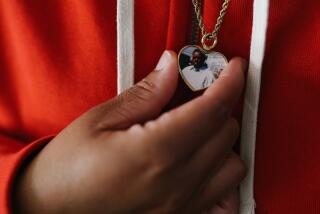L.A. County jail inmates trying to infect themselves with coronavirus, sheriff says

The security videos show inmates at the North County Correctional Facility passing around containers of water, taking turns taking swigs, or breathing into a single mask.
Sheriff Alex Villanueva said Monday that the actions were part of a scheme to get sick that led to a coronavirus outbreak in the jail last month. Eventually, 30 people in the two modules where the videos were recorded tested positive for the virus and two have since been released, said Asst. Sheriff Bruce Chase.
“It’s sad to think that someone deliberately tried to expose themselves to COVID-19,” Villanueva said. “Somehow there was some mistaken belief among the inmate population that if they tested positive that there was a way to force our hand and somehow release more inmates out of our jail environment — and that’s not gonna happen.”
He said investigators interviewed individuals involved but no one admitted to the scheme. “I think their behavior itself is what convicts them,” Villanueva said.
It’s unclear how the disease entered the two modules where the security videos were taken and whether inmates knew someone was sick when they were captured on video sharing the items.
In the video dated April 26, an inmate fills a container from the hot water dispenser inside a dorm and walks over to other inmates who appear lined up to see a nurse. In about a minute and a half, three inmates appear to take swigs. Deputies stand behind a counter just outside of the dorm. Villanueva said the inmates were also using the hot water to try to elevate their temperatures.
Sometime in the next day, nine inmates fell ill and were removed from the dorm. Eventually, 21 tested positive, Chase said.
That dorm had been quarantined since April 22 when an inmate who showed symptoms was pulled out and placed in isolation, Chase said. The same thing happened with a second inmate the next day. Both those inmates ended up testing negative, but there were other infections in the building. Chase said the first positive test in the North County jail came around April 15 from another dorm on the same floor.
In the second video, which is not dated but, according to Lt. John Satterfield, was taken April 15, inmates in a different module on another floor appear to share a Styrofoam cup and breathe into the same face mask. Nine inmates from that module ended up testing positive, Chase said.
Inmates had been quarantined at the North County jail since at least April 13, according to figures released almost daily by the Sheriff’s Department. Satterfield said the clips were “just a sampling of the many other videos being reviewed and used in the ongoing investigation.”
Jackie Clark, director of Correctional Health Services, which provides medical treatment to inmates, said the first positive infection at the North County jail was recorded just more than three weeks ago.
“They’re in dorm settings, so it’s easy once one person is positive, if everybody is still in close contact with each other, or not wearing masks” to get infected, Clark said. She said she reviewed footage from dorms where hardly any inmates were wearing masks and instructed the nursing staff to advise prisoners to wear the coverings around the clock, even to sleep.
Clark also said she was working to encourage more video court hearings to limit inmates from being transferred to and from court, noting that two or three L.A. County inmates were exposed to the virus from a public defender.
She said health staff has begun testing vulnerable asymptomatic people housed in the Correctional Treatment Center with the goal of eventually testing the entire jail population.
“Anyone who’s in any type of medical housing ... they’re our priorities,” she said. “Trying to go from highest risk down to lowest risk.”
As of Monday, 357 inmates in L.A. County jails have tested positive for the coronavirus infection. The number of infections has more than tripled since April 30. Officials, however, are conducting more testing, including of all new bookings. Of the inmates who have been infected, 117 have fully recovered.
More than 4,500 inmates are being held in quarantine, meaning they had been housed in a unit or had close contact with someone who either tested positive or is waiting for a result. Nearly 2,000 of them are housed at the North County jail in Castaic where the videos were taken.
Villanueva has significantly reduced the jail population in response to the pandemic. As of Monday, the jails, which typically house 17,000 people, held 11,723 inmates, according to the Sheriff’s Department.
Some critics contend that L.A. County has not done enough. A recent class-action lawsuit claims that inmates are not being tested even when they show symptoms and lack sufficient space for physical distancing. The lawsuit claims inmates don’t have enough soap or a safe way to dry their hands.
Patrisse Cullors, an activist whose uncle is a lead plaintiff, said in a statement that Villanueva is unable to protect people in L.A. County jails. She called on him to release more people and on the Board of Supervisors to move to offer COVID-19 testing to all prisoners and staff.
“In an attempt to demonize incarcerated people, he is taking a page right out of Trump’s playbook by gaslighting those who are already vulnerable and in absolute fear,” Cullors said. “Contrary to the Sheriff’s allegations, what I’ve been hearing from prisoners is that there isn’t enough soap, there is no hot water, that sheriff deputies are taunting folks inside by coughing in their presence, telling them they’re going to die of COVID.”
The Sheriff Civilian Oversight Commission voted last week to subpoena Villanueva to appear at its next meeting to discuss his handling of the coronavirus outbreak in the jails. It is the first use of the power approved by voters in March.
Inspector General Max Huntsman pointed to The Times’ reporting on one dorm at the Men’s Central Jail where 100 people were housed in bunks that are three feet apart and said he’s received complaints of bottlenecks in testing inmates with symptoms. He said 43 of the people in that dorm appeared eligible for release.
More to Read
Sign up for Essential California
The most important California stories and recommendations in your inbox every morning.
You may occasionally receive promotional content from the Los Angeles Times.












